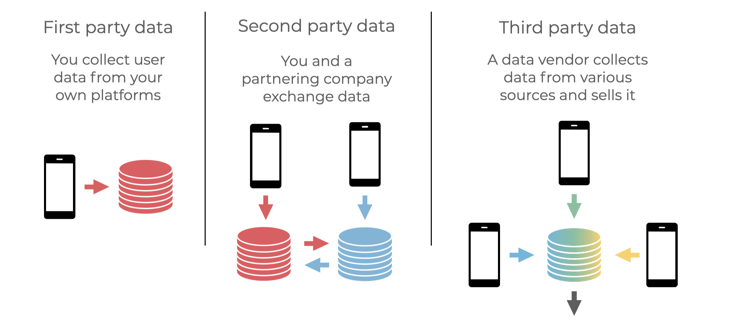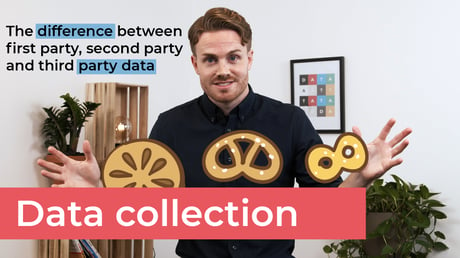What is the meaning of terms like third-party, second-party, and first-party data? In this post, we'll explore the differences between these types of data and examine how you can use each to improve your marketing strategy and campaigns.
Watch the video or read below to learn about:
- Cookies and why they are important for marketers
- The difference between first-party, second-party and third-party cookies
- What to do in a cookieless world
Cookies are a gold mine for marketers
Cookies. We all love them, but marketers love them more. Why? Because cookies allow marketers to get what they love even more than cookies - data!
With cookies, marketers can see things like who visited their website, track behavior, and understand what makes the best customer. They can do better targeting, better ads, and better marketing with all that information by looking at various audience segments.
What is party data?
Party data, that sounds like fun! Oh, wait — we're talking about first, second and third-party data. You know we still love any kind of data. But, not all data is the same — particularly when it comes to how you collect and manage it. But before we get into the nitty gritty, we need to talk about what exactly these different types of data are, how we collect them and why they're important.
TL;DR: what is first, second and third party data?
First-party → You collect it directly.
Second-party → You access a partner’s first-party data.
Third-party → You buy it from an external data aggregator.
What is first-party data?
The data that you have collected yourself, from your customers or audience, is called first-party. It can come from any source and includes website traffic, survey responses, or customer data stored in your CRM system. Because it's gathered first-hand, it's the most reliable and privacy-friendly type of data we can collect. And the best bit: it can be very valuable data indeed.
First-party information gives us everything we know about our customers' interaction — their preferences, email addresses and newsletter sign ups, purchase history, and web analytics from your online store. This gives us an edge over competitors because this info comes straight from our very own audience data!
Some example data points are:
- Purchase history
- Time spent on a website
- Number of visits
- Emails
- Phone numbers
It's valuable data because it's usually accurate, permission-based, and helps you build stronger, more personalized marketing while staying compliant with privacy regulations. Plus, with more restricted cookie consent coming into play, first-party cookies have become many marketers' go-to.
Also read our guide on using first party data in your marketing strategy, about collecting first party data and putting it to work.
The importance of consent when using consumer data
The user's consent is key to how marketers use their first-party data. And with GDPR, consumers have rights under European Union law. These rights include controlling what information companies collect about them and getting verifiable informed consent before processing any personal details. Online activities, like browsing habits or purchase history, are not exempt from this.
As long as it was generated from sources you own, your first-party data is considered more valuable than any other kind of business data.
Another way to leverage first party data is to send customers customized emails, for instance containing specific products they looked at in an app or webshop.
In short, first-party data is essential to a modern company's marketing efforts. Marketers can do many things with first-party data, such as creating ideal customer profiles to better plan future campaigns or using website behavior to optimize landing pages for visitors.
In short, marketers can improve campaign planning abilities because marketers know who's most likely interested or what products they would prefer (based on previous purchases). But it’s essential that your customers see you as a trusted partner who provides an optimal customer experience.
What’s second-party data?
Second-party data is basically first-party data that's shared with you by another company, usually a trusted partner.
For example, imagine you own a hotel booking website, and you establish a partnership with an air travel website, and you both start sharing data.
Now you have access to people that bought tickets to particular destinations and can target them with specific ads for hotels on those destinations. Pretty clever, right?
In practice, what's happening is you are allowing each other access to your first-party data. And that is second-party data to you.
Second-party data is great because it's still high-quality and privacy-compliant as it comes from direct customer relationships, but it expands your potential accuracy and reach beyond just your existing audience network. That means (like our example mentioned) more accurate targeting for potential new customers.
What is third-party data?
Third-party data is data collected by a business or company with no direct relationship with you or the customer.
This kind of data will be aggregated from many sources, in big lists like "men who enjoy football, aged 30-40", and then sold to advertising or analytics companies. Third-party data can be powerful, but you need to know from whom you're buying data so you can guarantee quality.
And if you buy a third-party data set (for instance: a list of people who like football, including their email address and demographics), make sure that this data is gathered in an honest way. Try asking the data marketplace or the vendor of the data, if the set contains customer data of people that gave consent to the sharing and reselling of their data.
It's worth bearing in mind that the data quality varies from type to type. Also, as privacy laws become more stringent and browsers restrict third-party cookies, many see the use of third-party cookies coming to an end.
Third-party data used to be the cornerstone of digital advertising, but is now declining due to privacy laws like GDPR and CCPA, in addition to the phase-out of third-party cookies on certain browsers. More and more marketers are learning to become less reliant on third-party data and investing more time and effort into collecting high-quality data of their own, and sharing with trusted partners.
Bonus: what's zero-party data?
We've got an extra one for you: zero-party data! Zero-party data is a step beyond first-party data — it’s the information that customers intentionally and proactively share with you. Unlike first-party data, which you gather from behavior (like clicks or purchases), zero-party data comes directly from what people tell you.
Examples could be quizzes or preferences, responses to surveys or feedback forms, as well as data shared through interactive experiences (like "find your perfect product" tools), or stated interests or intentions.
Zero-party data is interesting because it's thought of as the most transparent and trustworthy type of data as it's explicitly volunteered. It strengthens trust in brands, improves your options for personalization (which we know customers love and expect more and more frequently across multi-channel experiences), and it's fully compliant with privacy regulations.
Think of it like this: first party data tells you what someone did, but zero-party data tells you why they did it. That insight is super valuable for marketers and can help shape future campaigns.
It's time to get serious about data
As the world moves towards a "cookieless" future, marketers are being advised that they harness their power of first-party data and customer relationships — that is what you have complete control over how it’s collected and organized. Some companies do this by implementing specific data strategies, including:
- Nudging website users to create an account early on, so you can gather more information about them (as first party data)
- Partner up with publishers and other companies, and exchange data. This is especially smart if you have the same target audience
- Set up a marketing data warehouse or data management platform, so you leverage the data you have in the best way possible and get real time insights
- Keep up to date about digital privacy laws in the countries you operate in, and prevent breaching these laws.
Visual representation of 1st 2nd and 3rd party data:

Summary: first party data vs second party data vs third party data
- First party data collection happens when a company collects data on their own platforms, like their app or website;
- Second party data is data that is shared or sold by one company with another company, where these two companies know and trust each other;
- Third party data is data collected by companies that don't have a direct relationship with the buying party, and can be bought at an online third party data marketplace.
To learn more about web cookies and prepare for third-party cookie death, check out this FAQ!
